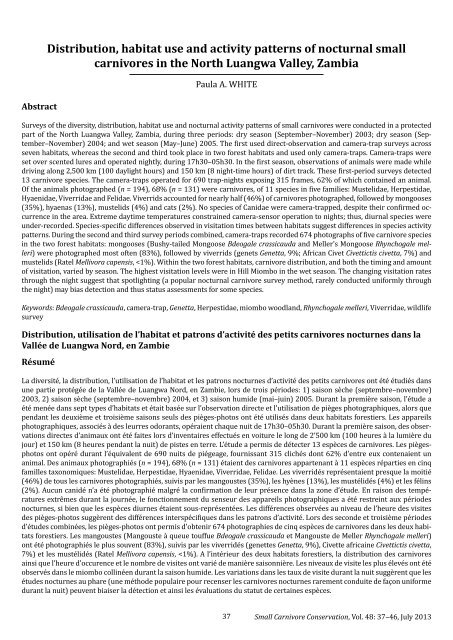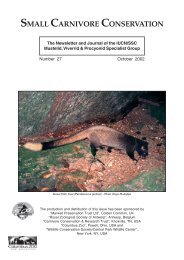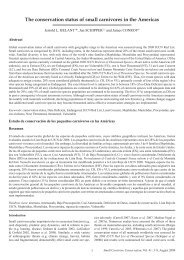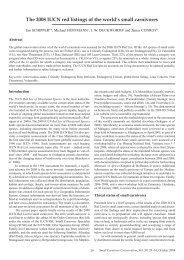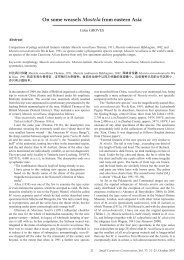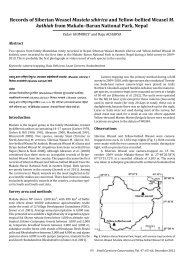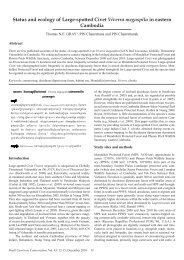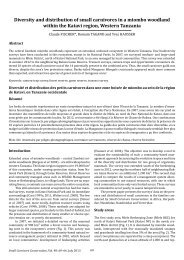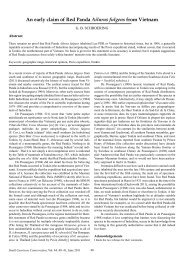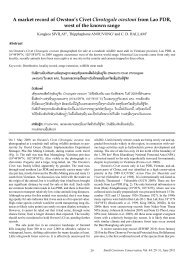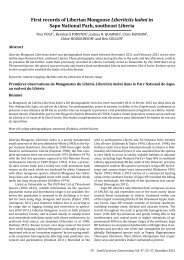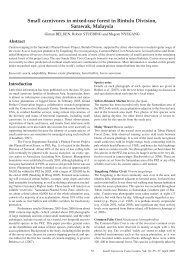Distribution, habitat use and activity patterns of nocturnal small ...
Distribution, habitat use and activity patterns of nocturnal small ...
Distribution, habitat use and activity patterns of nocturnal small ...
You also want an ePaper? Increase the reach of your titles
YUMPU automatically turns print PDFs into web optimized ePapers that Google loves.
Abstract<strong>Distribution</strong>, <strong>habitat</strong> <strong>use</strong> <strong>and</strong> <strong>activity</strong> <strong>patterns</strong> <strong>of</strong> <strong>nocturnal</strong> <strong>small</strong>carnivores in the North Luangwa Valley, ZambiaPaula A. WHITESurveys <strong>of</strong> the diversity, distribution, <strong>habitat</strong> <strong>use</strong> <strong>and</strong> <strong>nocturnal</strong> <strong>activity</strong> <strong>patterns</strong> <strong>of</strong> <strong>small</strong> carnivores were conducted in a protectedpart <strong>of</strong> the North Luangwa Valley, Zambia, during three periods: dry season (September–November) 2003; dry season (September–November)2004; <strong>and</strong> wet season (May–June) 2005. The first <strong>use</strong>d direct-observation <strong>and</strong> camera-trap surveys acrossseven <strong>habitat</strong>s, whereas the second <strong>and</strong> third took place in two forest <strong>habitat</strong>s <strong>and</strong> <strong>use</strong>d only camera-traps. Camera-traps wereset over scented lures <strong>and</strong> operated nightly, during 17h30–05h30. In the first season, observations <strong>of</strong> animals were made whiledriving along 2,500 km (100 daylight hours) <strong>and</strong> 150 km (8 night-time hours) <strong>of</strong> dirt track. These first-period surveys detected13 carnivore species. The camera-traps operated for 690 trap-nights exposing 315 frames, 62% <strong>of</strong> which contained an animal.Of the animals photographed (n = 194), 68% (n = 131) were carnivores, <strong>of</strong> 11 species in five families: Mustelidae, Herpestidae,Hyaenidae, Viverridae <strong>and</strong> Felidae. Viverrids accounted for nearly half (46%) <strong>of</strong> carnivores photographed, followed by mongooses(35%), hyaenas (13%), mustelids (4%) <strong>and</strong> cats (2%). No species <strong>of</strong> Canidae were camera-trapped, despite their confirmed occurrencein the area. Extreme daytime temperatures constrained camera-sensor operation to nights; thus, diurnal species wereunder-recorded. Species-specific differences observed in visitation times between <strong>habitat</strong>s suggest differences in species <strong>activity</strong><strong>patterns</strong>. During the second <strong>and</strong> third survey periods combined, camera-traps recorded 674 photographs <strong>of</strong> five carnivore speciesin the two forest <strong>habitat</strong>s: mongooses (Bushy-tailed Mongoose Bdeogale crassicauda <strong>and</strong> Meller’s Mongoose Rhynchogale melleri)were photographed most <strong>of</strong>ten (83%), followed by viverrids (genets Genetta, 9%; African Civet Civettictis civetta, 7%) <strong>and</strong>mustelids (Ratel Mellivora capensis,
WhiteMots clés: Bdeogale crassicauda, forêt de miombo, Genetta, inventaire faunistique, mangoustes, piège-photographique, Rhynchogalemelleri, viverridésIntroductionMany African <strong>small</strong> carnivore species are inconspicuous <strong>nocturnal</strong>forest dwellers (Ewer 1973, Smithers 1983) that are difficultto detect: as a consequence, little is known about them.Nevertheless, forest carnivores are <strong>of</strong> interest both from anacademic st<strong>and</strong>point <strong>and</strong> in light <strong>of</strong> global trends prioritisingresource extraction <strong>and</strong> <strong>use</strong> without adequate consideration <strong>of</strong>environmental impacts (Greene 1988). It is <strong>of</strong>ten assumed thatby virtue <strong>of</strong> their size, <strong>small</strong> carnivores are less prone to directpersecution than are the larger species. However, illegal tradein bush meat <strong>and</strong> skins (e.g. Colyn et al. 1988, Ray et al. 2002,Golden 2009, Shepherd & Shepherd 2010, Dolch 2011), l<strong>and</strong>conversion <strong>and</strong> deforestation are all current threats to at leastsome <strong>small</strong> African carnivore species (Crooks 2002, Kauffmanet al. 2007, Dunham & Gaubert 2008). The extent to which humanpractices threaten regional populations <strong>of</strong> <strong>small</strong> carnivoresis only beginning to be investigated (Colón 2002, Crooks2002, Azlan 2003, Kauffman et al. 2007, Cheyne et al. 2010a,Mathai et al. 2010, Wilting et al. 2010). The paucity <strong>of</strong> baselinedata about many <strong>small</strong> carnivore species hinders assessment<strong>of</strong> impacts <strong>and</strong> development <strong>of</strong> appropriate conservation strategies(Greene 1988, Ray et al. 2002).Camera-traps are growing in popularity as an invaluabletool for detecting secretive species (e.g. Foresman & Pearson1998, Cutler & Swann 1999), replacing more invasive types <strong>of</strong>research such as radio-collaring. Increasingly, camera-trapsare documenting first records <strong>of</strong> little-known carnivores inlittle-known ecosystems (Brink et al. 2002, Goldman & Winther-Hansen2003, Rovero et al. 2006, Charoo et al. 2010,Cheyne et al. 2010b, Jenks et al. 2010, Moqanaki et al. 2010),<strong>and</strong> may clarify species abundance (Gerber et al. 2010). Forexample, Bushy-tailed Mongoose Bdeogale crassicauda, a speciespreviously considered rare (Taylor 1987), was among themost frequently camera-trapped species at several localities inTanzania’s Eastern Arc Mountains (De Luca & Mpunga 2005).Camera-traps can also be <strong>use</strong>d to identify individuals (Karanth& Nichols 1998, Sequin Larrucea et al. 2007), <strong>and</strong> to quantify<strong>activity</strong> <strong>patterns</strong> (Sequin Larrucea et al. 2007) or behaviour(Picman & Schriml 1994). For species about which almostnothing is known, even short-term camera-trapping studies(Charoo et al. 2010, Cheyne et al. 2010b) or data accrued incidentally(González-Maya et al. 2009) can contribute significantinsight concerning group size, <strong>activity</strong> pattern, <strong>habitat</strong> <strong>use</strong> <strong>and</strong>geographic range.Zambia’s Luangwa Valley has a high species richness(Pomeroy 1993, Barnes 1998, BirdLife International 2000,WWF-SARPO 2003) <strong>and</strong> lies adjacent to areas <strong>of</strong> known highspecies endemism, e.g. Bangweulu swamp (Zambia), Nyikaplateau (Malawi), the Southern Highl<strong>and</strong>s (Tanzania) <strong>and</strong> theAlbertine Rift (Democratic Republic <strong>of</strong> Congo) (White 1983).As a transverse <strong>of</strong>fshoot <strong>of</strong> the greater African Rift Valley system,the Luangwa Valley is known to contain many endemicforms (Ansell 1960, 1978). Twenty-two species <strong>of</strong> carnivoreshave been reported from this region (Table 1), within six families:dogs (Canidae), mustelids (Mustelidae), mongooses (Her-pestidae), hyaenas (Hyaenidae), civets <strong>and</strong> genets (Viverridae)<strong>and</strong> cats (Felidae) (Kingdon 1977, 1997, Ansell 1978, Skinner& Smithers 1990).The Luangwa Valley is experiencing rapid human populationgrowth <strong>and</strong> rural expansion (Chenje & Johnson 1994) resultingin environmental change (Stuart et al. 1990, Dalal-Clayton& Child 2003, WWF-SARPO 2003). Apart from a few studiesthat foc<strong>use</strong>d on larger species (Yamazaki 1996, Yamazaki &Bwalya 1999, Anderson et al. 2011), the ecology <strong>of</strong> LuangwaValley’s <strong>small</strong> carnivore community is unknown. The LuangwaValley is just one <strong>of</strong> many areas in Africa lacking a long-termmonitoring programme foc<strong>use</strong>d on <strong>small</strong> carnivore conservation.The present study therefore surveyed carnivores by camera-traps<strong>and</strong> direct observations in the dry <strong>and</strong> wet seasons <strong>of</strong>2003–2005. It took place in an area <strong>of</strong> protected, intact <strong>habitat</strong>with minimal human disturbance. Thus, its results provide astarting point for future studies, especially in other regionswithin <strong>and</strong> beyond the Luangwa Valley that are experiencingrapid human population growth, rural expansion <strong>and</strong> resultantanthropogenic change.MethodsStudy areaThe study took place in the North Luangwa National Park(11°47′S, 32°10′E), Luangwa Valley, north-eastern Zambia,south-central Africa (Fig. 1). The Luangwa Valley is a transverseextension <strong>of</strong> the greater African Rift Valley system, borderednorthwest by the Muchinga Escarpment <strong>and</strong> southeastby Malawi’s Nyika Plateau. To the northeast lie Tanzania’sEastern Arc Mountains. The Luangwa River arises from theMafinga Mountains at about 2,400 m a.s.l. It is fed by the perennialMwaleshi River that originates in the Muchinga Escarpment,<strong>and</strong> by several other rivers that flow seasonally from theescarpment <strong>and</strong> plateau. The broad, silt-laden Luangwa Rivercuts a s<strong>and</strong>y swath through the Valley bottom on its way tojoin the Zambezi River in the south.Vegetation throughout the region is predominantly MopaneColophospermum mopane woodl<strong>and</strong> <strong>and</strong> miombo Brachystegiawoodl<strong>and</strong> (MTENR 2005). On a more localised scale,different vegetation types occur patchily throughout the LuangwaValley, especially in relation to elevational changes <strong>and</strong>topographic microclimates (Smith 1998) (Fig. 2).During the single long rainy season from Decemberto April, the Luangwa River reaches full flood. Using eachmonth’s average daily mean, the coolest temperatures (10 °C)occur in June <strong>and</strong> July, after the rains. From that point, temperaturesrise steadily, peaking in October at 37 °C. Outlyingwater sources have dried up by that time, so herbivores <strong>and</strong>carnivores alike congregate along the rivers to await the onset<strong>of</strong> the rains in late November.Sampling methodologyPart I. All surveys in 2003 were conducted during the dryseason (September–November). Surveys consisted <strong>of</strong> directsearches for animals during daylight driving circuits <strong>and</strong>Small Carnivore Conservation, Vol. 48, July 201338
Small carnivores in Luangwa Valley, ZambiaTable 1. Number <strong>of</strong> camera-trap <strong>and</strong> direct-observation records <strong>of</strong> each carnivore species* in North Luangwa National Park,Zambia, during 2003–2005.SpeciesNumber <strong>of</strong> recordsDirect observation(daytime)Direct observation(night-time)Camera-trapPhase ICamera-trapPhase IICanidaeSide-striped Jackal Canis adustus 0 0 0 0African Wild Dog Lycaon pictus 0 0 0 0MustelidaeHoney Badger Mellivora capensis 0 0 5 2African Clawless Otter Aonyx capensis 0 0 0 0HerpestidaeEgyptian Mongoose Herpestes ichneumon 0 0 0 0Common Slender Mongoose Herpestes sanguineus 11 0 0 0Common Dwarf Mongoose Helogale parvula 2 0 0 0B<strong>and</strong>ed Mongoose Mungos mungo 1 0 0 0Marsh Mongoose Atilax paludinosus 0 0 0 0White-tailed Mongoose Ichneumia albicauda 0 0 8 0Meller’s Mongoose Rhynchogale melleri 0 1 13 162Bushy-tailed Mongoose Bdeogale crassicauda 0 0 21 287Unidentified Meller’s/Bushy-tailed Mongoose 0 0 3 114HyaenidaeSpotted Hyaena Crocuta crocuta 2 5 17 0ViverridaeGenet Genetta 0 2 16 62African Civet Civettictis civetta 0 0 45 47FelidaeWild Cat Felis sylvestris 0 0 0 0Serval Felis serval 0 0 0 0Caracal Felis caracal 0 0 1 0Leopard Panthera pardus 0 1 1 0Lion Panthera leo 4 1 1 0Cheetah Acinonyx jubatus 0 0 0 0Total 20 10 131 674*All species potentially present, based on historical information, are listed. Four genets are known from Zambia: Miombo GenetG. angolensis, South African Small-spotted Genet G. felina, Common Small-spotted Genet G. genetta <strong>and</strong> Rusty-spotted Genet G.maculata (Gaubert et al. 2005); the historical records from the Luangwa Valley, <strong>of</strong> ‘Blotched Genet Genetta tigrina’ <strong>and</strong> ‘Servaline(or Pardine) Genet Genetta servalina’, would need re-evaluation in the light <strong>of</strong> taxonomic <strong>and</strong> nomenclatural change.night drives using spotlights (both at a speed <strong>of</strong> 25 km/hr),<strong>and</strong> camera-trapping at scented lures. Camera-trap stationswere situated along transects in each <strong>of</strong> seven <strong>habitat</strong> typesthat spanned an elevational gradient from the Luangwa Riverin the Valley floor (600 m) to near the top <strong>of</strong> the MuchingaEscarpment (1,177 m). Seven <strong>habitat</strong>s defined based onpredominant vegetation type (Fig. 2) were surveyed: 1) EscarpmentForest (dry, evergreen), 2) Hill Miombo, 3) WoodedGrassl<strong>and</strong> Mosaic, 4) Valley Riverine Complex (dry), 5)Valley Riverine Complex (perennial stream), 6) Combretum–Terminalia Woodl<strong>and</strong> <strong>and</strong> 7) Secondary Annual Grassl<strong>and</strong>(Fig. 1).Part II. Two <strong>habitat</strong>s (Escarpment Forest <strong>and</strong> Hill Miombo)were intensively camera-trapped during a three-monthdry season (September–November 2004) <strong>and</strong> a two-monthwet season (May–June 2005). The time- <strong>and</strong> date-stampedphotographs were <strong>use</strong>d to examine seasonal differences inspecies composition <strong>and</strong> visitation (<strong>activity</strong>) <strong>patterns</strong> within<strong>and</strong> between the two forest <strong>habitat</strong>s.Camera-trap stationsCamera-trap stations were located 10–50 m from roads, 0.5–1.0 km apart, <strong>and</strong> at least 1.0 km from transitions to other <strong>habitat</strong>s.In Part I, ten camera-traps were set for 8–11 days alonga transect within a homogenous <strong>habitat</strong> type, then moved toa new transect-line in a different <strong>habitat</strong>. During Part II, fivecamera-traps were operated at evenly spaced static locationsin each <strong>of</strong> the two forested <strong>habitat</strong>s for the entire dry (2004)<strong>and</strong> wet (2005) sampling period (Fig. 1). A ‘trap-night’ was theequivalent <strong>of</strong> one camera set for one night (i.e. a 12-hr period).Each camera-trap station consisted <strong>of</strong> a remotely activated35 mm instamatic camera with electronic flash (TrailmasterTM35-1) coupled to a motion/heat detector (TrailmasterTM550) (Trailmaster Inc., Lenexa, Kansas). The camera wasset to be triggered by animals within 20 m <strong>and</strong> a 150° radius <strong>of</strong>the camera. In addition, a 5-min delay was set to avoid repeatedlyphotographing an individual lingering at a scent station.More than 85% <strong>of</strong> the time-consecutive photographs separatedby 10 minutes or more contained different species. An39Small Carnivore Conservation, Vol. 48, July 2013
WhiteFig. 1. North Luangwa National Park, Zambia, showing camera-trappingtransect locations <strong>and</strong> associated <strong>habitat</strong> types. Park borders designatedby irregular lines are rivers. Interior grey lines are dirt roads. Transects 1–7were sampled during the dry season 2003. Transects 1–2 were resampledduring the dry season 2004 <strong>and</strong> the wet season 2005.Camera-trap systems were secured to trees at a height <strong>of</strong>1.5 m <strong>and</strong> aimed towards a scent lure <strong>of</strong> minute amounts (
Small carnivores in Luangwa Valley, ZambiaTable 2. Habitat features, camera-trapping effort <strong>and</strong> number <strong>of</strong> visits for each transect during Part I (dry season 2003) <strong>of</strong> this studyin North Luangwa National Park, Zambia.Transect Habitat Type Elevation range 1 (m) Number <strong>of</strong> camera-trap-nights Number <strong>of</strong> visits1 Escarpment Forest 1,177−1,026 100 692 Hill Miombo 975−758 90 503 Wooded Grassl<strong>and</strong> Mosaic 717−643 110 424 Valley Riverine Complex (dry) 640−629 80 265 Valley Riverine Complex (perennial stream) 636−608 100 436 Combretum–Terminalia Woodl<strong>and</strong> 658−687 100 277 Secondary Annual Grassl<strong>and</strong> 599−630 110 581The lowest <strong>and</strong> highest points in the transect.Fig. 3. Patterns <strong>of</strong> <strong>nocturnal</strong> carnivore visits to camera-trap stations in each <strong>of</strong> seven <strong>habitat</strong> types sampled during the dry season 2003 in NorthLuangwa National Park, Zambia. For each <strong>habitat</strong>, results shown are for all carnivore species combined.dawn was not uncommon (Fig. 3). Differences in <strong>activity</strong> <strong>patterns</strong>were attributed to variable species composition amongthe different <strong>habitat</strong> types.Part II. Species composition in two forest <strong>habitat</strong>sOf 392 visits recorded to the Escarpment Forest camera-traps,the most frequently photographed visitors were Meller’s Mongoose<strong>and</strong> Bushy-tailed Mongoose combined (Table 3). Thesewere also the most-photographed visitors in Hill Miombo.However, a larger percentage <strong>of</strong> the 282 total visits in Hill Miombocomprised other species, including genets <strong>and</strong> AfricanCivet Civettictis civetta (Table 3). Genets were recorded more<strong>of</strong>ten in the wet season than in the dry, in the Hill Miombo17× so, in the Escarpment Forest 2.5× so. Civets were photographedin both forest types during the dry season, but onlyin the Hill Miombo during the wet, where they were recorded7× more <strong>of</strong>ten than during the dry. Ratels Mellivora capensiswere detected very rarely in the Hill Miombo, <strong>and</strong> not at all inEscarpment Forest (Table 3).Seasonal variation in visiting <strong>patterns</strong>Within each <strong>of</strong> the two forest <strong>habitat</strong>s, wet- <strong>and</strong> dry-seasonvisiting <strong>patterns</strong> were compared (Fig. 4).Meller’s <strong>and</strong> Bushy-tailed Mongooses combined showedrelatively uniform <strong>nocturnal</strong> visit <strong>patterns</strong>, becoming activeshortly after dusk (18h00–19h00) <strong>and</strong> visiting <strong>of</strong>ten until tapering<strong>of</strong>f just before dawn (Fig. 4). In both forest types, visitswere much more frequent during the wet season than in the dry.41Small Carnivore Conservation, Vol. 48, July 2013
WhiteTable 3. Occurrence <strong>of</strong> <strong>small</strong> carnivores on photographs in each <strong>of</strong> tw<strong>of</strong>orest <strong>habitat</strong>s in North Luangwa National Park, Zambia, dry season 2004<strong>and</strong> wet season 2005.SpeciesNumber <strong>of</strong> visitsEscarpmentForestHillMiomboDry Wet Dry WetRhynchogale melleri 33 76 9 44Bdeogale crassicauda 50 138 11 88Unidentified Rhynchogale/Bdeogale 10 55 7 42Genetta 7 18 2 35Civettictis civetta 5 0 5 37Mellivora capensis 0 0 1 1Total 105 287 35 247Additionally, during the wet season in Hill Miombo, mongoosesshowed a sharp peak in visits around 21h00 (Fig. 4).Genets were active early in the evening, visiting alreadyat dusk when camera-traps began operating, <strong>and</strong> continuingthroughout the night. Visiting distinctly peaked at 20h00–21h00 <strong>and</strong> at 02h00–03h00. Genets made more visits in both<strong>habitat</strong>s during the wet than in the dry season (Fig. 4). In both<strong>habitat</strong>s, the largest peaks in visiting were consistently around20h00 <strong>and</strong> 02h00, although during the wet season genets visitedin the Hill Miombo during other times as well.African Civet showed polymodal <strong>nocturnal</strong> visiting duringthe dry season, beginning only after total darkness (19h00–20h00) with secondary peaks at 00h00–01h00 <strong>and</strong> 03h00–04h00, tapering <strong>of</strong>f abruptly in the hours before dawn. Duringthe wet season, Civets visited earlier in the evening than in thedry season <strong>and</strong> visited throughout the night hours with the exception<strong>of</strong> a lull around 21h00 (Fig. 4).All species showed the highest visitation levels in the HillMiombo during the wet season, when they remained relativelyactive throughout the night. Throughout the year, both genets<strong>and</strong> African Civet showed nightly lulls following polymodalpeaks <strong>of</strong> <strong>activity</strong>.DiscussionRemote cameras proved effective in detecting <strong>nocturnal</strong> <strong>small</strong>carnivores in the Luangwa Valley, in particular viverrids <strong>and</strong>mongooses in densely vegetated <strong>habitat</strong>s. Scent stationsworked well to attract hyaenas <strong>and</strong> mustelids within camerarange, but few pictures <strong>of</strong> cats, <strong>and</strong> none <strong>of</strong> canids wereobtained. Methodology was similar across all <strong>habitat</strong>s, thuspotential biasing effects, e.g. camera-avoidance by species orindividuals, or the effects <strong>of</strong> roads, were relatively constant.Overall, 60% <strong>of</strong> carnivore species previously reported fromthe region were detected by camera-traps <strong>and</strong> driving surveyscombined over a 2-month dry season.Time constraints on camera operation precluded detectionFig. 4. Comparison <strong>of</strong> <strong>nocturnal</strong> visits to camera-traps during dry <strong>and</strong> wet seasons for all <strong>small</strong> carnivore species photographed within each <strong>of</strong> tw<strong>of</strong>orest <strong>habitat</strong>s in North Luangwa National Park, Zambia.Small Carnivore Conservation, Vol. 48, July 201342
Small carnivores in Luangwa Valley, Zambia<strong>of</strong> species active only by day. However, this does not explainthe paucity <strong>of</strong> visits by larger ground-dwelling carnivores activeat night, i.e. Lion Panthera leo, Leopard Panthera pardus<strong>and</strong> Side-striped Jackal Canis adustus. The Luangwa Valleyholds about 500–600 Lions (PAW own data) <strong>and</strong> high densities<strong>of</strong> Leopards (Ansell 1960, Nowell & Jackson 1996). Catpresence was evidently not accurately represented by cameratraps,perhaps reflecting low appeal <strong>of</strong> the scents <strong>use</strong>d. In contrast,African Wild Dogs Lycaon pictus are relatively few, <strong>and</strong>Side-striped Jackals have declined drastically over the past 30years (A. Carr verbally 2005), so the lack <strong>of</strong> canid detectionsperhaps reflects their local rarity. The ca<strong>use</strong> <strong>of</strong> Jackal declineis unknown. It might relate to disease transfer from DomesticDogs Canis familiaris, which have increased dramatically inthe Luangwa Valley during the past 10+ years (PAW own obs.).Those species detected varied in the amount <strong>and</strong> pattern<strong>of</strong> visitation by <strong>habitat</strong> type. Camera stations were set>5 km from the nearest human dwellings, rendering <strong>activity</strong><strong>patterns</strong> unlikely to be influenced by people as might beexpected <strong>of</strong> <strong>small</strong> carnivores for example given the opportunity<strong>of</strong> scavenging on camp-site scraps. Excepting this study’snight-surveys, park roads were closed to traffic after dark.Furthermore, scent lures were presented systematically, soany effects they may have had on carnivore visitation <strong>patterns</strong>should be uniform across all sampling stations. Differences inoverall visitation <strong>patterns</strong> between <strong>habitat</strong>s were attributedto species composition, although lunar phase may have alsoinfluenced predator movements (Waser 1980). Time-stampedphotographs provided <strong>activity</strong> <strong>patterns</strong> for each species (formongooses <strong>and</strong> genets, for aggregates <strong>of</strong> species). Consideration<strong>of</strong> species-specific <strong>activity</strong> times is important in designingspotlight surveys, beca<strong>use</strong> survey times may bias detection<strong>and</strong> abundance estimates if they are routinely conducted duringa period <strong>of</strong> low <strong>activity</strong> for a particular species. However,<strong>activity</strong> <strong>patterns</strong> <strong>of</strong> partly arboreal <strong>and</strong> scansorial species maynot be adequately represented when relying on camera-trapsthat detect ground-level movements.Further dissection <strong>of</strong> mongoose <strong>and</strong> genet visitation datamight detect differences in <strong>activity</strong> <strong>patterns</strong> between sympatricspecies. More detailed analyses <strong>of</strong> species <strong>activity</strong> timesmight lend evidence <strong>of</strong> temporal niche partitioning (Pianka1969) as a mechanism reducing competition between the LuangwaValley’s sympatric carnivores. Temporal partitioningcan facilitate coxistence among similar-sized sympatric carnivores(Ray 1997, Fedriani et al. 1999, Karanth & Sunquist2000). However, Waser (1980) commented that overlap inboth preferred vegetation types <strong>and</strong> foraging times within<strong>small</strong> <strong>nocturnal</strong> carnivore communities was not unusual. Likewise,the large overlaps <strong>of</strong> foraging times among the <strong>small</strong> carnivoresinhabiting the Luangwa Valley’s forests were possiblyfacilitated by the <strong>use</strong> <strong>of</strong> different types or sizes <strong>of</strong> prey (seeBothma et al. 1984, Sunquist et al. 1989, Karanth & Sunquist2000, Walker et al. 2007).Luangwa Valley’s forests provide a year-round hometo several species <strong>of</strong> <strong>nocturnal</strong> <strong>small</strong> carnivores, at leastBushy-tailed Mongoose, Meller’s Mongoose, genets <strong>and</strong> AfricanCivet. In the north <strong>of</strong> its range, Bushy-tailed Mongooseco-occurs with genets, White-tailed Mongoose Ichneumia albicauda<strong>and</strong> Zorilla Ictonyx striatus (Sale & Taylor 1970), incoastal forests with African Civet (Taylor 1986), <strong>and</strong> in Tan-zania’s Eastern Arc Mountains, with many <strong>nocturnal</strong> <strong>small</strong>carnivores including Marsh Mongoose Atilax paludinosus,Meller’s Mongoose, Jackson’s Mongoose Bdeogale jacksoni,White-tailed Mongoose, Servaline Genet Genetta servalina,Rusty-spotted Genet, Common Small-spotted Genet, AfricanCivet, African Palm Civet N<strong>and</strong>inia binotata <strong>and</strong> Ratel (DeLuca & Mpunga 2005). The present study confirmed BushytailedMongoose co-occurrence with African Civet <strong>and</strong> genetsin its western-central range, <strong>and</strong> is one <strong>of</strong> very few documentedassociations <strong>of</strong> it with Meller’s Mongoose (see DeLuca & Mpunga 2005).While Bushy-tailed Mongoose was observed directly onlyonce, it was among the most frequently photographed speciesin both the Escarpment Forest <strong>and</strong> Hill Miombo Forest communities.Similarly, it was the most frequently camera-trappedcarnivore in the montane <strong>and</strong> lowl<strong>and</strong> forests <strong>of</strong> Tanzania’sEastern Arc Mountains (De Luca & Mpunga 2005, H<strong>of</strong>fman2008), <strong>and</strong> <strong>use</strong>s a wide variety <strong>of</strong> other <strong>habitat</strong> types (Taylor1987). The even lesser-known Meller’s Mongoose is usuallyassociated with woodl<strong>and</strong> (Kingdon 1997), but has been photographedin montane bamboo forest <strong>and</strong> open wooded grassl<strong>and</strong>in Tanzania at an altitude <strong>of</strong> 1,850 m (De Luca & Mpunga2005). The present study recorded Meller’s Mongoose in analtitudinal range <strong>of</strong> 750−1,175 m in Luangwa Valley, withinthat reported by Kingdon (1997).Both Bushy-tailed <strong>and</strong> Meller’s Mongooses are generallyperceived as uncommon, yet in this study were frequentlycamera-trapped. This adds to the <strong>small</strong> carnivore conservationimportance <strong>of</strong> Miombo Woodl<strong>and</strong>s, which are amongthe earth’s most biologically valuable <strong>and</strong> diverse ecoregions(Rodgers et al. 1996, Olson & Dinerstein 1998) with a plantcommunity <strong>of</strong> particular importance to humans <strong>and</strong> other animals(Frost 1996, Barnes 1998, Williams et al. 2007, Munishiet al. 2010). Throughout Africa, Miombo Woodl<strong>and</strong>s are heavily<strong>use</strong>d for resource extraction by humans (Misana et al. 1996,Mapaure & Campbell 2002), but well-managed forests cansupport many <strong>small</strong> carnivores <strong>of</strong> many species (Wilting et al.2010). Changes in carnivore community structure can havepr<strong>of</strong>ound impacts on ecosystem dynamics (Terborgh 1988,Crooks & Soulé 1999), so studies examining species compositionin relation to <strong>habitat</strong> perturbations help detect <strong>and</strong> documentchanges, <strong>and</strong> design regionally-effective conservationstrategies (Kauffman et al. 2007, Mathai et al. 2010).Future studiesFurther analysis <strong>of</strong> this study’s photographs will allow morepositive identifications among similar-looking species (genets,<strong>and</strong> Bushy-tailed <strong>and</strong> Meller’s Mongooses), <strong>and</strong> thus moredetailed information on species within each sampled <strong>habitat</strong>.Re-evaluation <strong>of</strong> species-level visitation data may suggestdifferences in <strong>activity</strong> <strong>patterns</strong> that indicate temporal nichepartitioning. This could help explain how similarly-sized mongooses<strong>and</strong> genets, respectively, reduce competition, especiallyduring the dry season when resources are less abundant.GIS mapping <strong>of</strong> species locations will be <strong>use</strong>d to analyse carnivores’micro<strong>habitat</strong> <strong>use</strong>. Camera-trapping throughout the24-hr period would allow closer to complete documentation<strong>of</strong> the Luangwa Valley’s <strong>small</strong> carnivore community. Surveyingsites under different l<strong>and</strong>-<strong>use</strong> regimes would clarify impacts <strong>of</strong>anthropogenic perturbations on the Luangwa Valley’s carnivore43Small Carnivore Conservation, Vol. 48, July 2013
Whitespecies. For species with individually unique coat <strong>patterns</strong> (AfricanCivet, genets, Spotted Hyaena), photographic capture–recapturemay provide insights on short- <strong>and</strong> longer-term spatial-<strong>use</strong><strong>patterns</strong> <strong>and</strong> on density. For species not individuallyrecognisable, occupancy surveys (MacKenzie et al. 2002) canestimate abundance more reliably than ‘Relative AbundanceIndices’, by incorporating detection probabilities (MacKenzieet al. 2002, Linkie et al. 2007, Ancrenaz et al. 2012).AcknowledgementsI thank the Zambia Wildlife Authority for permission to perform thisresearch. Frankfurt Zoological Society kindly provided housing <strong>and</strong>logistical support during the field portions <strong>of</strong> this project. I thankPaul Smith for providing the excellent vegetation map. I am gratefulto A. Wilting, E. Do Linh San, D. Boyd <strong>and</strong> one anonymous reviewerfor insightful comments <strong>and</strong> suggestions that improved this manuscript.Thanks are extended to A. Carr, Kapani Lodge, Mfuwe, Zambia,for providing a historical perspective on carnivores in the LuangwaValley.ReferencesAncrenaz, M., Hearn, A. J., Ross, J., Sollmann, R. & Wilting, A. 2012.H<strong>and</strong>book for wildlife monitoring using camera-traps. NaturalResources Office, Chief Minister’s Department, Kota Kinabalu,Sabah, Malaysia.Anderson, N. E., Mubanga, J., Fevre, E. M., Picozzi, K., Eisler, M. C.,Thomas, R. & Welburn, S. C. 2011. Characterisation <strong>of</strong> the wildlifereservoir community for human <strong>and</strong> animal trypanosomiasisin the Luangwa Valley, Zambia. PLoS Neglected Tropical Diseases5(6): (e1211) 1–16.Ansell, W. F. H. 1960. Mammals <strong>of</strong> Northern Rhodesia. GovernmentPrinter, Lusaka, Northern Rhodesia [Zambia].Ansell, W. F. H. 1978. The mammals <strong>of</strong> Zambia. National Parks & WildlifeService, Chilanga, Zambia.Azlan J., M. 2003. The diversity <strong>and</strong> conservation <strong>of</strong> mustelids, viverrids,<strong>and</strong> herpestids in disturbed forest in Peninsular Malaysia.Small Carnivore Conservation 29: 8–9.Barnes, K. N. (ed.) 1998. Important Bird Areas <strong>of</strong> Southern Africa.BirdLife South Africa, Johannesburg, South Africa.BirdLife International 2000. Threatened birds <strong>of</strong> the world. Lynx Editions<strong>and</strong> BirdLife International, Barcelona, Spain, <strong>and</strong> Cambridge,U.K.Bothma, J. D. P., Nel, J. A. J. & Macdonald, A. 1984. Food niche separationbetween four sympatric Namib desert carnivores. Journal <strong>of</strong>Zoology, London 202: 327–340.Brink, H., Topp-Jørgensen, J. E., Marshall, A. R. & Fanning, E. 2002. Firstrecord in 68 years <strong>of</strong> Lowe’s Servaline Genet. Oryx 36: 323–324.Charoo, S. A., Sharma, L. K., Sathyakumar, S. & Naqash, R. Y. 2010. Firstrecord <strong>of</strong> Small Indian Civet Viverricula indica in the KashmirHimalaya, India. Small Carnivore Conservation 43: 42–43.Chenje, M. & Johnson, P. (eds) 1994. State <strong>of</strong> the environment in SouthernAfrica. Southern African Research <strong>and</strong> Documentation Centre,Harare, Zimbabwe.Cheyne, S. M., Husson, S. J., Chadwick, R. J. & Macdonald, D. W. 2010a.Diversity <strong>and</strong> <strong>activity</strong> <strong>of</strong> <strong>small</strong> carnivores <strong>of</strong> the Sabangau peatswampforest, Indonesian Borneo. Small Carnivore Conservation43: 1–7.Cheyne, S. M., Husson, S. J. & Macdonald, D. W. 2010b. First Otter CivetCynogale bennettii photographed in Sabangau peat-swamp forest,Indonesian Borneo. Small Carnivore Conservation 42: 25–26.Colón, C. P. 2002. Ranging behaviour <strong>and</strong> <strong>activity</strong> <strong>of</strong> the Malay Civet(Viverra tangalunga) in a logged <strong>and</strong> an unlogged forest in DanumValley, East Malaysia. Journal <strong>of</strong> Zoology, London 257: 473–485.Colyn, M., Dudu, A. & Mbaelele, M. 1988. Données sur l’exploitationdu petit et moyen gibier des forêts ombrophiles du Zaire. Natureet Faune 3: 22−39.Crooks, K. R. 2002. The relative sensitivities <strong>of</strong> mammalian carnivoresto <strong>habitat</strong> fragmentation. Conservation Biology 16: 488–502.Crooks, K. R. & Soulé, M. E. 1999. Meso-predator release <strong>and</strong> avifaunalextinctions in a fragmented system. Nature 400: 563–566.Cutler, T. L. & Swann, D. E. 1999. Using remote photography in wildlifeecology: a review. Wildlife Society Bulletin 27: 571–581.Dalal-Clayton, B. & Child, B. 2003. Lessons from Luangwa. InternationalInstitute for Environment <strong>and</strong> Development (Wildlife <strong>and</strong>Development Series 13) <strong>and</strong> South Luangwa Management Unit,London, U.K., <strong>and</strong> Chipata, Zambia.De Luca, D. & Mpunga, N. 2005. Carnivores <strong>of</strong> the Udzungwa Mountains:presence, distributions <strong>and</strong> threats. Wildlife ConservationSociety, Mbeya, Tanzania.Dolch, R. 2011. Species composition <strong>and</strong> relative sighting frequency<strong>of</strong> carnivores in the Analamazaotra rainforest, eastern Madagascar.Small Carnivore Conservation 44: 44–47.Dunham, A. & Gaubert, P. 2008. Genetta johnstoni. In IUCN 2012.IUCN Red List <strong>of</strong> Threatened Species. Version 2012.1. .Downloaded on 13 August 2012.Ewer, R. 1973. The carnivores. Cornell University Press, Ithaca, NewYork, U.S.A.Fedriani, J. M., Palomares, F. & Delibes, M. 1999. Niche relationsamong three sympatric Mediterranean carnivores. Oecologia121: 138–148.Foresman, K. R. & Pearson, D. E. 1998. Comparison <strong>of</strong> proposed surveytechniques for detection <strong>of</strong> forest carnivores. Journal <strong>of</strong> WildlifeManagement 62: 1217–1226.Frost, P. 1996. The ecology <strong>of</strong> miombo woodl<strong>and</strong>s. Pp. 11–58 inCampbell, B. (ed.) The miombo in transition: woodl<strong>and</strong>s <strong>and</strong> welfarein Africa. Centre for International Forestry Research, Bogor,Indonesia.Gaubert, P., Taylor, P. J. & Veron, G. 2005. Integrative taxonomy <strong>and</strong>phylogenetic systematics <strong>of</strong> the genets (Carnivora, Viverridae,Genetta): a new classification <strong>of</strong> the most speciose carnivorangenus in Africa. Pp. 371–383 in Huber, B. A., Sinclair, B. J. & Lampe,K.-H. (eds) African biodiversity: molecules, organisms, ecosystems.Springer, Bonn, Germany.Gerber, B., Karpanty, S. M., Crawford, C., Kotschwar, M. & R<strong>and</strong>rianantenaina,J. 2010. An assessment <strong>of</strong> carnivore relative abundance<strong>and</strong> density in the eastern rainforests <strong>of</strong> Madagascar using remotely-triggeredcamera traps. Oryx 44: 219–222.Golden, C. D. 2009. Bushmeat hunting <strong>and</strong> <strong>use</strong> in the Makira Forest,north-eastern Madagascar: a conservation <strong>and</strong> livelihoods issue.Oryx 43: 386–392.Goldman, H. V. & Winther-Hansen, J. 2003. The <strong>small</strong> carnivores <strong>of</strong> Unguja:results <strong>of</strong> a photo-trapping survey in Jozani Forest Reserve,Zanzibar, Tanzania. Norwegian Polar Institute, Tromsø, Norway.González-Maya, J. F., Schipper, J. & Benitez, A. 2009. Activity <strong>patterns</strong><strong>and</strong> community ecology <strong>of</strong> <strong>small</strong> carnivores in the Talamanca region,Costa Rica. Small Carnivore Conservation 41: 9–14.Greene, H. W. 1988. Species richness in tropical predators Pp. 259–280 in Almeda, F. & Pringle, C. M. (eds) Tropical rainforests: diversity<strong>and</strong> conservation. California Academy <strong>of</strong> Sciences, SanFrancisco, U.S.A.Small Carnivore Conservation, Vol. 48, July 201344
Small carnivores in Luangwa Valley, ZambiaH<strong>of</strong>fmann, M. 2008. Bdeogale crassicauda. In IUCN 2012. IUCN RedList <strong>of</strong> Threatened Species. Version 2012.1. . Downloaded on 13 August 2012.Jenks, K. E., Wanghongsa, S., Songsasen, N., Leimgruber, P. & Howard,J. 2010. Camera-trap evidence <strong>of</strong> Large-spotted Civet Viverramegaspila in Khao Ang Rue Nai Wildlife Sanctuary <strong>and</strong> Khao YaiNational Park, Thail<strong>and</strong>. Small Carnivore Conservation 42: 19–21.Karanth, K. U. & Nichols, J. D. 1998. Estimation <strong>of</strong> Tiger densities inIndia using photographic captures <strong>and</strong> recaptures. Ecology 79:2852–2862.Karanth, K. U. & Sunquist, M. E. 2000. Behavioural correlates <strong>of</strong> predationby Tiger (Panthera tigris), Leopard (Panthera pardus)<strong>and</strong> Dhole (Cuon alpinus) in Nagarahole, India. Journal <strong>of</strong> Zoology,London 250: 255–265.Kauffman, M. J., Sanjayan, M., Lowenstein, J., Nelson, A., Jeo, R. M. &Crooks, K. R. 2007. Remote camera-trap methods <strong>and</strong> analysesreveal impacts <strong>of</strong> rangel<strong>and</strong> management on Namibian carnivorecommunities. Oryx 41: 70–78.Kingdon, J. 1977. East African mammals: an atlas <strong>of</strong> evolution in Africa,IIIA. Carnivora. Academic Press, London, U.K. & New York, U.S.A.Kingdon, J. 1997. The Kingdon field guide to African mammals. AcademicPress, San Diego, U.S.A.Linkie, M., Dinata, Y., Nugroho, A. & Haidir, I. A. 2007. Estimating occupancy<strong>of</strong> a Data Deficient mammalian species living in tropicalrainforests: Sun Bears in the Kerinci Seblat region, Sumatra. BiologicalConservation 137: 20–27.MacKenzie, D. I., Nichols, J. D., Lachman, G. B., Droege, S., Royle, J. A. &Langtimm, C. A. 2002. Estimating site occupancy rates when detectionprobabilities are less than one. Ecology 83: 2248–2255.Mapaure, I. N. & Campbell, B. M. 2002. Changes in miombo woodl<strong>and</strong>cover in <strong>and</strong> around Sengwa Wildlife Research Area, Zimbabwe,in relation to Elephants <strong>and</strong> fire. African Journal <strong>of</strong> Ecology 40:212–219.Mathai, J., Hon, J., Juat, N., Peter, A. & Gumal, M. 2010. Small carnivoresin a logging concession in the Upper Baram, Sarawak, Borneo.Small Carnivore Conservation 42: 1–9.Misana, S., Mung’ong’o, C. & Mukamuri, B. 1996. Miombo woodl<strong>and</strong>sin the wider context: macro-economic <strong>and</strong> inter-sectoral influences.Pp. 73–99 in Campbell, B. (ed.) The miombo in transition:woodl<strong>and</strong>s <strong>and</strong> welfare in Africa. Centre for International ForestryResearch, Bogor, Indonesia.Moqanaki, E. M., Jafarzadeh, F., Shaerbafi, E. & Farhadinia, M. S. 2010.First camera-trap record <strong>of</strong> the European Badger Meles melesfrom Iran. Small Carnivore Conservation 43: 28–29.[MTENR] Ministry <strong>of</strong> Tourism, Environmental <strong>and</strong> Natural Resources.2005. GAP analysis <strong>of</strong> the representation <strong>of</strong> the different vegetationtypes in protected areas designated for the conservation <strong>of</strong>biodiversity. Reclassification <strong>and</strong> Effective Management <strong>of</strong> ProtectedAreas System Project, Lusaka, Zambia.Munishi, P. K. T., Mringi, S., Shirima, D. D. & Linda, S. K. 2010. The role<strong>of</strong> the miombo woodl<strong>and</strong>s <strong>of</strong> the Southern Highl<strong>and</strong>s <strong>of</strong> Tanzaniaas carbon sinks. Journal <strong>of</strong> Ecology <strong>and</strong> the Natural Environment2: 261–269.Nowell, K. & Jackson, P. (eds) 1996. Wild cats: status survey <strong>and</strong> conservationaction plan. IUCN, Gl<strong>and</strong>, Switzerl<strong>and</strong>.Olson, D. & Dinerstein, E. 1998. The Global 200: a representationapproach to conserving the Earth’s most biologically valuableecoregions. Conservation Biology 12: 502–515.Pianka, E. R. 1969. Sympatry <strong>of</strong> desert lizards (Ctenotus) in westernAustralia. Ecology 50: 1012–1030.Picman, J. & Schriml, L. M. 1994. A camera study <strong>of</strong> temporal <strong>patterns</strong><strong>of</strong> nest predation in different <strong>habitat</strong>s. Wilson Bulletin 106:456–465.Pomeroy, D. 1993. Centers <strong>of</strong> high biodiversity in Africa. ConservationBiology 7: 901–907.Ray, J. C. 1997. Comparative ecology <strong>of</strong> two African forest mongooses,Herpestes naso <strong>and</strong> Atilax paludinosus. African Journal <strong>of</strong> Ecology35: 237–253.Ray, J. C., Stein, J. T. & Bushmeat Crisis Task Force 2002. BCTF factsheet: forest carnivores <strong>and</strong> the African bushmeat trade. BushmeatCrisis Task Force, Washington, D.C., U.S.A.Rodgers, A., Salehe, J. & Howard, G. 1996. The biodiversity <strong>of</strong> miombowoodl<strong>and</strong>s. P. 12 in Campbell, B. (ed.) The miombo in transition:woodl<strong>and</strong>s <strong>and</strong> welfare in Africa. Centre for International ForestryResearch, Bogor, Indonesia.Rovero, F., Doggart, N., Bowkett, A. & Burgess, N. 2006. New recordsfor Lowe’s Servaline Genet from the Eastern Arc Mountains <strong>of</strong>Tanzania. Oryx 40: 139.Sale, J. B. & Taylor, M. E. 1970. A new four-toed mongoose from Kenya,Bdeogale crassicauda nigrescens ssp. nov. Journal <strong>of</strong> the East AfricanNatural History Society 28: 11–16.Sequin Larrucea, E., Brussard, P. F., Jaeger, M. M. & Barrett, R. H. 2007.Cameras, Coyotes, <strong>and</strong> the assumption <strong>of</strong> equal detectability.Journal <strong>of</strong> Wildlife Management 71: 1682–1689.Shepherd, C. R. & Shepherd, L. A. 2010. The trade in Viverridae <strong>and</strong>Prionodontidae in Peninsular Malaysia with notes on conservation<strong>and</strong> legislation. Small Carnivore Conservation 42: 27–29.Skinner, J. D. & Smithers, R. H. N. 1990. The mammals <strong>of</strong> the SouthernAfrican subregion. University <strong>of</strong> Pretoria, Pretoria, South Africa.Smith, P. P. 1998. A reconnaissance survey <strong>of</strong> the vegetation <strong>of</strong> theNorth Luangwa National Park, Zambia. Bothalia 28: 197–211.Smithers, R. H. N. 1983. The mammals <strong>of</strong> the Southern African subregion.University <strong>of</strong> Pretoria, Pretoria, South Africa.Stuart, S. N., Adams, R. J. & Jenkins, M. 1990. Biodiversity in Sub-SaharanAfrica <strong>and</strong> its isl<strong>and</strong>s. Conservation, management <strong>and</strong> sustainable<strong>use</strong>. IUCN (Occasional Papers <strong>of</strong> the IUCN Species SurvivalCommission 6), Gl<strong>and</strong>, Switzerl<strong>and</strong>.Sunquist, M. E., Sunquist, F. & Daneke, D. E. 1989. Ecological separationin a Venezuelan llanos carnivore community. Pp. 197–232in Redford, K. H. & Eisenberg, J. F. (eds) Advances in Neotropicalmammalogy. S<strong>and</strong>hill Crane Press, Gainsville, U.S.A.Taylor, M. E. 1986. The biology <strong>of</strong> the Four-toed Mongoose Bdeogalecrassicauda. Cimbebasia (A) 8: 187–193.Taylor, M. E. 1987. Bdeogale crassicauda. Mammalian Species 294:1–4.Terborgh, J. 1988. The big things that run the world – a sequel to E.O.Wilson. Conservation Biology 2: 402–403.Walker, S. R., Novaro, A. J., Perovic, P., Palacios, R., Donadio, E., Lucherini,M., Pia, M. & Lopes, M. S. 2007. Diets <strong>of</strong> three species <strong>of</strong> Andeancarnivores in high-altitude deserts <strong>of</strong> Argentina. Journal <strong>of</strong>Mammalogy 88: 519–525.Waser, P. M. 1980. Small <strong>nocturnal</strong> carnivores: ecological studies inthe Serengeti. African Journal <strong>of</strong> Ecology 18: 167–185.White, F. 1983. The vegetation <strong>of</strong> Africa, a descriptive memoir to accompanythe UNESCO/AETFAT/UNSO vegetation map <strong>of</strong> Africa.United Nations Educational, Scientific <strong>and</strong> Cultural Organization,Paris, France.Williams, C. A., Hanan, N. P., Neff, J. C., Scholes, R. J., Berry, J. A., Denning,A. S. & Baker, D. F. 2007. Africa <strong>and</strong> the global carbon cycle.Carbon Balance <strong>and</strong> Management Journal 2(2): 2–3.45Small Carnivore Conservation, Vol. 48, July 2013
WhiteWilting, A., Samejima, H. & Mohamed, A. 2010. Diversity <strong>of</strong> Borneanviverrids <strong>and</strong> other <strong>small</strong> carnivores in Deramakot Forest Reserve,Sabah, Malaysia. Small Carnivore Conservation 42: 10–13.WWF-SARPO 2003. Conservation in the Miombo Ecoregion – Southern<strong>and</strong> Eastern Africa. World Wildlife Fund, Southern Africa RegionalProgramme Office, Harare, Zimbabwe.Yamazaki, K. 1996. Social variation <strong>of</strong> Lions in a male-depopulatedarea in Zambia. Journal <strong>of</strong> Wildlife Management 60: 490–497.Yamazaki, K. & Bwalya, T. 1999. Fatal Lion attacks on local peoplein the Luangwa Valley, eastern Zambia. South African Journal <strong>of</strong>Wildlife Research 29: 19–21.Center for Tropical Research,University <strong>of</strong> California,Los Angeles, 90095 U.S.A.E-mail: paw@carnivoreconservation.comSmall Carnivore Conservation, Vol. 48, July 201346


